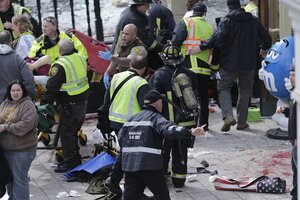The challenge in the Boston Marathon bombing
The act of terror in the Boston Marathon bombing was swiftly met by acts of help and comfort for victims and others. Such actions point to the need to affirm all of that which the bomber sought to destroy.

Medical workers and others aid injured people at the finish line of the 2013 Boston Marathon following a bomb explosion April 15.
AP Photo
The identity of the Boston Marathon bomber remains unknown, but that should not dampen the many efforts to challenge the possible motives for this terrorist tragedy. In fact, one challenge started within seconds of the blasts.
Instead of fleeing the smoky carnage near the finish line in Boston’s Back Bay, dozens of spectators and runners joined the police and rushed to aid the injured, despite the risk of another bomb. They helped relieve the fear and suffering of victims by flooding the scene with compassion and assurance, whether it was with a tourniquet, a wheelchair, words of comfort, or a prayer.
They ranged from New England Patriots guard Joe Andruzzi to peace activist Carlos Arredondo. Local hotels and restaurants helped those runners and others affected by the devastation. Many runners and spectators vowed to return next year.
Many of those helping at the scene acted in the spirit of Psalms 91: “Thou shalt not be afraid for the terror by night; nor for the arrow that flieth by day.” Across the city, people reminded each other of the need to affirm all of that which the bomber sought to destroy. They noted the spirit of the world’s oldest marathon and the meaning of the local Patriots’ Day holiday that celebrates the opening battles of the American Revolutionary War.
As Americans discovered after 9/11 as well as many others, how we react to terrorism is as important as catching the terrorists. Fear is the terrorists’ most desired outcome. And while higher degrees of caution and safety may be needed, fear must not be the answer. Whatever reasons are used to justify the killing of civilians, they will eventually be made powerless when enough people attest to and live by the values of a free, caring, and peaceful society.
Boston itself has a notable legacy of people who have affirmed the enduring power of good in the face of evil. Two cases stand out:
The most recent one is called “the Boston miracle.” Started in the early 1990s to counter a wave of gang violence, it involved a collaboration of police and black clergy to reach the most-hardened gang leaders. Church leaders like the Rev. Eugene Rivers offered unconditional love and the hope of a better life to gangs while police promised swift punishment for even minor lawbreaking. Ministers, for example, gave their cellphone numbers to gang members. Within two years, gang violence was cut in half.
The other case came after the Boston Massacre of 1770, in which British soldiers killed five people protesting the British occupation of the city.
While the people demanded harsh justice, John Adams recognized that the colony must affirm civic values such as rule of law in order to earn respect and liberty. He offered to be legal counsel to Thomas Preston, captain of the troops, defending him in court.
“Judgment of Death against those Soldiers would have been as foul a Stain upon this Country as the Executions of the Quakers or Witches, anciently,” wrote Adams later, after he became the second American president. Standing up for such values cost him dearly – about half of his law practice. Eventually, however, the colony saw the wisdom of embracing these ideals as a form of defense to imperial tyranny.
Would-be terrorists may be hard to reach with such an approach. But like that crowd rushing into the smoke of Monday’s blasts, the challenge to terror and its motives must be made. If dozens of people can do it under such fearful circumstances, why not millions on a daily basis?

